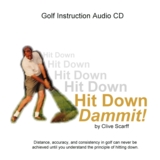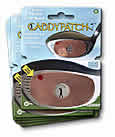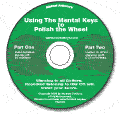The Short Game Part 4: Putting Contours
Read
other Parts from the
Technology & Distance
series and Short Game
series here, Archives.
If you'd
like one on
one explanations
about the topic,
sign up for the PGI
Member Select Club and
I'll answer all your
questions in a prompt,
thorough fashion.
Now on to this week's
topic.
IV. What
if the slope of
the green changes
between your ball
and the hole?
In
my last newsletter,
I explained how
to read putts using
the plumb bobbing
technique and a matrix I
have developed
to translate the
plumb read to how
much the putt actually
breaks. This method,
which I advocate
is quite accurate
as long as your
plumbing is accurate,
does assume the
slope of the green
is the same everywhere.
As your probably
aware, however,
green contours
change.
Take
for instance a
putt where the
balls in on a mound
and the slope at
the hole is much
less. Plumbing
such a putt would
not give anywhere
near an accurate
read. This is a
putt where the
slope is high early
in the putt and
low late. Early
in a putt, the
ball will be moving
quite quickly and
therefore will
not be as greatly
affected compared
to when the ball
is moving slowly.
Late in the putt,
as the ball slows,
even a little slope
will cause a lot
of break. The slope
of the mound, in
this case, won't
cause the ball
to break very much.
The
opposite case is
the ball being
on a part of the
green which has
little slope and
the hole on a part
which has a lot
of slope. In this
case, the largest
slope occurs late
in the putt (when
the ball is moving
slowly) and the
ball will be greatly
affected (it will
break a lot).
What
about uphill and
downhill putts?
An uphill putt
with break will
break less than
a downhill putt
with similar slope.
On a downhill putt,
the ball is struck
by the putter with
less force and
is thus going more
slowly. The ball,
therefore, takes
more time to get
to the hole and
is more greatly
affected by the
slope (ball breaks
more). Experience
will tell you how
much more or less
putts break depending
on whether they
are downhill or
uphill.
On
downhill putts
that are quite
fast, I have had
a lot of success
by putting the
ball off the toe
of the putter (about
halfway between
the sweet spot
and the end of
the blade). I find
I can still make
a normal stroke
(long and smooth)
without fearing
hitting the ball
way past the hole.
I have found that
when taking a normal
stroke, it's easy
to not follow through
and pull the putt
out of fear of
hitting it too
far. In addition,
I find I don't
need to shorten
my stroke up to
compensate for
the downhill. I
just make a normal
putt for the length
and in effect mis-hit
the ball off the
toe of the blade.
Another
thing I have found
helpful on severe
uphill and downhill
putts (tiered greens)
is to imagine a
position short
or long of the
hole at which to
aim. On a downhill
putt, trying to
hit to a position
short of the hole
compensates for
the amount of downhill.
Likewise, trying
to hit to a position
long of the hole
compensates for
the amount of uphill.
The amount short
or long one aim's
depends on the
change
in elevation.
Next
time, I'll provide
you with more
great tips dealing
wedge play, specifically
distance control.
How do you swing
to hit 60 yards
compared with 40
Yards? Is it just
fee? It doesn't
have to be!!
Purchase
my Longest
Golf Ball Report (over
300 sold so far)
in which I statistically
analyze
distances
of over 90 different
golf balls with
differing constructions.
The balls were
hit
using a mechanical
hitting machine.
Play
with my Driver
Distance Calculator.
You can input such
variables as loft
and clubhead speed
to determine the
optimum loft. I'll
be adding to it
soon so that you
can input different
golf ball parameters
such as speed and
spin.
A list of resources that have been used to produce this newsletter
can be found on my
website here.
The next newsletter's topic will be on wedge play. If you
have any questions
ahead of time, send
me an email.
The focus
of my site
is to utilize science
and math to lower
your score. New technology
is one
way to achieve this,
but to be honest,
the technology is
one small piece of
the puzzle.
To actually improve significantly,
we all need to:
1. Improve our swings using CD
Interactive, Hit
Down Dammit!
2. Learn how to swing simpler
like the Iron Byron
with the great coffee
table book, Swing
Machine Golf!
3. Improve our physical fitness
and strength.
The
Golf Trainer Power
Performance Programô
4. Improve our mental games.
Golf
Mind Software
5. Improve our Probable
Golf games.
Learn how to make better
choices on the course
through knowing how
shot patterns and reading
the elements and course
better.
Click on the links above to
take a look at
ways that I personally
use myself and
recommend you try
as well.
Hope
I provided some useful
ways for to become
better prepared for
you best golf season
ever.
Ken Tannar
If you'd like to opt out of this newsletter, send
me an email with the subject "opt
out, please"
|











